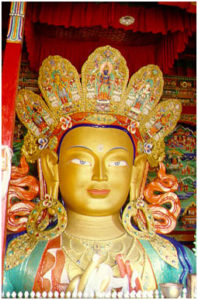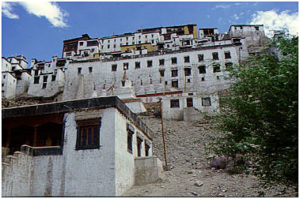Vinay Lal
See also: Buddha
Buddhism’s Disappearance from India
The Revival of Buddhism in India
By the sixth century BCE, the specific doctrines and customary social and religious practices associated with the Aryans had been in place for nearly a millennium. The social formation known as “caste” had introduced certain rigidities into Indian life, and though some of the early texts, such as the Upanishads, of the religion that much later would be known as Hinduism suggested a climate of open intellectual inquiry and a predilection for metaphysical thinking, Hinduism had most likely become reduced to a set of ritual practices and dogmas. It is against this backdrop that one must view the emergence of the so-called heterodox systems, Buddhism and Jainism. Both these systems questioned the authority of the Vedas, and of the sacerdotal caste,the Brahmins, entrusted with the preservation and interpretation of the Vedas; and both condemned the excessive ritualism associated with the religion, such as the various sacrifices. The Buddha and Mahavira, the founder of Jainism, alike stressed the importance of ahimsa or non-violence, and the increasing turn towards vegetarianism among Indians after the sixth century BCE can be attributed to the influence of Buddhist and Jaina teachings. Both Buddhism and Jainism introduced the monastic conception of life into India.
The fundamental precepts of Buddhism are, in the first instance, associated with the teachings of the Buddha, though the history of Buddhism embraces, as one can well imagine, the ‘institutionalization’ of the religion into specific schools of thought. The Buddha taught the “Four Noble Truths”, namely: all existence is suffering (dukha); the cause of suffering is ignorance (avidya) and selfish desire; if there is suffering, there is a cure for it; and the cure for suffering lies in the eight-fold path of right beliefs, right speech, right conduct, right mode of livelihood, right effort, right mindedness, right meditation, and right aspirations. The knowledge of the roots of sorrow, and the elimination of desire, leads to the state of nirvana, which is also the state of wisdom and compassion.
(Thus the representation of the Buddha as the compassionate one.) In the teachings of the Buddha are found more than a mere glimmer of the doctrines contained in the Upanishads, and to some extent he can be seen as resuscitating the earliest philosophical teachings of Hinduism. However, the Buddha articulated more specific principles of philosophical thought, such as the law of dependent origination, or the idea that there is nothing permanent in the empirical self.
Where the Upanishads affirmed the presence of an underlying reality, or the perception that the atman (individual soul) and the Brahman (the absolute; the cosmic soul) are one, the Buddha would neither affirm nor deny the existence of the soul. In this respect, the Buddha resolutely set himself up against the metaphysics of the Upanishads, denying that it was possible to say anything about the existence of something permanent behind the empirical self or the transient (anicca) world. In other words, the Buddha chose to keep silent on the nature of the absolute reality and the self. Consequently, it has become the norm to view the Buddha as an agnostic, though he is perhaps better understood as an ethical thinker.(Thus the representation of the Buddha as the compassionate one.) In the teachings of the Buddha are found more than a mere glimmer of the doctrines contained in the Upanishads, and to some extent he can be seen as resuscitating the earliest philosophical teachings of Hinduism. However, the Buddha articulated more specific principles of philosophical thought, such as the law of dependent origination, or the idea that there is nothing permanent in the empirical self.
In his own lifetime, some of the disciples gathered around the Buddha became members of a monastic order (sangha), and they were enjoined to observe the vows of brahmacharya (celibacy), aparigraha (non-possessions, or poverty), and ahimsa (non-violence). Giving up the life of the householder, the bhikku or Buddhist monk went from place to place, relying upon alms for their daily bread. Following the death of the Buddha, most likely in 483 BCE (though according to the Sinhalese tradition he died in 544 BCE), an attempt was made to codify the Buddha’s teachings, but sectarian differences emerged nearly at the outset of the history of Buddhism. At the second of the two great councils held to determine the canon, a schism occurred, and the main body of the monks, who described themselves as the inheritors of the Buddha’s own doctrines, became associated with the path known as Theravada (“Teachings of the Elders”). Later this would become known as the Hinayana (“The Lesser Vehicle”), which is the school of Buddhism that still prevails in Sri Lanka, Myanmar, Thailand, Cambodia, and Laos. The Theravada canon, compiled in either Pali or a form of Sanskrit, has in its entirety been preserved in Sri Lanka, though the writings of the other early sects, when they survived, are found largely in Chinese or Tibetan translations.
The Theravada canon is generally known as Tripitaka, after the three sections into which it is divided. The first portion, Vinaya (Conduct), contains the rules of conduct enjoined upon monks and nuns of the Buddhist monastic orders; the second portion or pitaka contains the discourses (sutta) attributed mainly to the Buddha, and which are the most authoritative guide to the teachings of the Buddha. Finally, the third pitaka, Abhidhamma, or supplementary doctrines, consists of works that summarize and systematize the ideas contained in the Sutta, and these are believed to be later provenance. The last teachings of the Buddha are found in the Mahaparinirbbana Sutta, in the instructions left to his intimate disciple Ananda: “So, Ananda, you must be your own lamps, be your own refuge. Take refuge in nothing outside yourselves. Hold firm to the truth as a lamp and a refuge, and do not look for refuge to anything besides yourselves. A monk becomes his own lamp and refuge by continually looking on his body, feelings, perceptions, moods, and ideas in such a manner that he conquers the cravings and depressions of ordinary men and is always strenuous, self-possessed, and collected in mind.”
The other principal school of Buddhism besides the Hinayana is the Mahayana, which described itself as “The Greater Vehicle”. It arose in India shortly after the beginning of the Christian Era. Hinayana Buddhism had developed the idea of the arhat (saint), and the Buddha was seen not merely, or even, as a savior as much as an example. The tendency to worship the emblems of the Buddha — such as the wheel, his footprints, or the empty throne (denoting his renunciation of his material kingdom) — or the Three Jewels of Buddhism, epitomized in the formula, “I take refuge in the Buddha, I take refuge in the Doctrine, I take refuge in the Order”, had grown over time. This earlier ideal, which held out the example of the arhat to the believer, would be replaced in Mahayana by the idea of the bodhisattva, or a would-be Buddha who endeavored to bring ordinary people on to the right path. Faith in the bodhisattva was thought to make possible spiritual achievement. Where Hinayana thought of Nirvana as annihilation, Mahayana thought of it as attainment. The two most important philosophical schools associated with Mahayana were to be Madhyamika, founded by Nagarjuna, and Yogarara.



